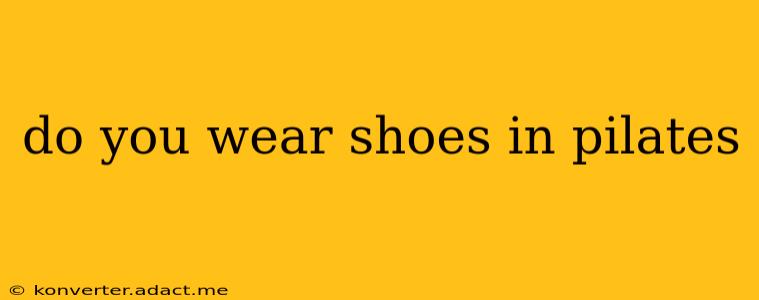Do You Wear Shoes in Pilates? A Comprehensive Guide
Pilates, known for its focus on core strength, body alignment, and controlled movements, often sparks the question: Do you wear shoes in Pilates? The short answer is generally no. But let's delve deeper into the reasons why and explore some exceptions.
Why You Shouldn't Wear Shoes in Pilates
The primary reason for going barefoot or wearing socks in Pilates is to maintain optimal foot and ankle mobility and stability. Pilates emphasizes precise movements originating from the core and extending throughout the body. Shoes restrict this natural movement and can hinder your ability to:
- Feel the floor: Direct contact with the floor allows for a better sense of your body's alignment and subtle shifts in your weight distribution. This connection is crucial for proper form and maximizing the effectiveness of each exercise.
- Engage your intrinsic foot muscles: Shoes often restrict the natural movement of the toes and small muscles in your feet. Engaging these muscles is important for stability and balance during Pilates.
- Prevent slippage: While it might seem counterintuitive, bare feet provide more grip on most Pilates studio floors than shoes. This is particularly important during exercises that require a strong connection to the ground.
- Avoid injuries: Restrictive footwear can lead to imbalances, improper form, and potentially increase the risk of injuries.
What About Socks?
Socks are generally acceptable in Pilates, particularly if you find bare feet uncomfortable or your feet tend to get sweaty. However, choose socks that are thin, non-slip, and don't bunch up. Thick, bulky socks can hinder your foot's connection to the surface and interfere with your balance.
Are There Ever Exceptions?
While most Pilates instructors will recommend going barefoot or wearing thin socks, there might be some exceptions:
- Hygiene concerns: If you're concerned about hygiene in a shared studio environment, socks are a practical solution.
- Medical conditions: Individuals with certain foot conditions might need to wear supportive footwear. Always consult your doctor or physical therapist for personalized recommendations.
- Specific equipment: Certain Pilates equipment, such as the reformer or Cadillac, might involve straps or attachments that could potentially catch on bare feet. In these instances, thin socks might be preferred.
- Personal preference: While less common, some individuals might find that wearing lightweight, flexible shoes allows them to achieve a better sense of grounding. However, this should be discussed with your instructor beforehand.
What Type of Socks Are Best for Pilates?
Choosing the right socks is essential for a comfortable and effective Pilates session. Look for socks that are:
- Thin and breathable: Avoid thick socks that restrict movement and hinder your ability to connect with the floor.
- Non-slip: Grippy socks will provide added stability during your workout.
- Moisture-wicking: Materials that wick away sweat will keep your feet dry and comfortable.
- Low-profile: Avoid socks with seams or extra padding that could cause discomfort or interfere with your movements.
In conclusion, while there might be rare exceptions, the general consensus amongst Pilates instructors is that you should go barefoot or wear thin, non-slip socks during your Pilates sessions. This allows for optimal foot and ankle mobility, enhances your connection to the floor, and improves the overall effectiveness and safety of your workout. Remember to always communicate with your instructor if you have any concerns or specific needs regarding footwear.
